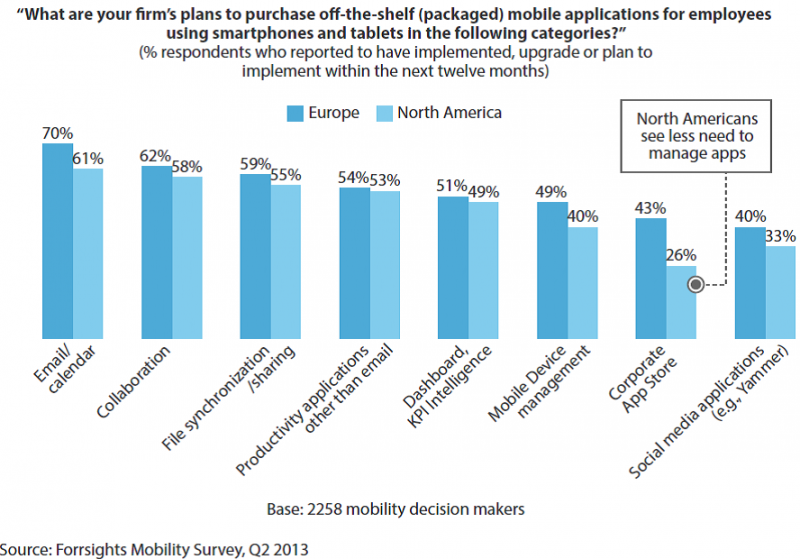The Mobile Mind Shift Has Arrived In The European Enterprise
European IT departments actively deploy mobile capabilities in their organization, edging ahead of their North American counterparts on the journey to provide managed corporate services to their employees, according to Forrester’s Forrsights Mobility Survey, Q2 2013. Our data also showed us that:
- European IT leaders prefer to control the distribution of corporate applications. Forty-three percent of European respondents report that they have implemented or plan to implement a corporate mobile application store within the next 12 months compared to only 26% of their North American counterparts (see Figure 1). These findings point to a key difference in the European approach: less self-sourcing by the employee, no laissez faire attitude to application sourcing, but active guidance on corporate devices and applications. European IT leaders we spoke to confirm these findings.
- European mobile deployments look unstructured and often lack stakeholder alignment. While there is much activity around building out mobile application delivery and investing in the right infrastructure to support mobile engagement, there is no visible pattern or strategy behind many deployments. Many European enterprises fail to apply the classic strategy of starting with a mobile strategy, rolling out mobile device support, and ensuring mobile productivity.

Figure 1: Europeans Lead The Deployment Of Corporate App Stores
Other key findings from the survey:
- Many companies have not yet addressed the basics. Some 30% of European respondents and nearly 40% of North American respondents report that they have neither deployed mobile push email services nor have plans for this basic set of services.
- Two-fifths of European respondents are pleased with their MDM platform. Close to 40% of European respondents report that the mobile device management (MDM) platform they've deployed has exceeded their expectations for user experience, data security, and better compliance with regulation.
- Many European respondents are spending more to support mobile engagement. Close to two-thirds of the European respondents have increased their expenditure to upgrade the supporting infrastructure for mobile engagement. At the top of the shopping list? Storage, new application development, and network connectivity.
What it means: It is imperative to structure your mobile deployments now in order to avoid waste and confusion. Successfully implementing a strategy involves the following three key steps:
- Turn your vision for mobile engagement into reality. Despite the urgency with which many IT leaders regard this issue, many organizations have yet to turn their vision into a firm road map or establish an empowered program organization to see the implementation through.
- Create a structured buildout plan for the second wave. The implementation phase starts with an audit of the current state of play. What are you lacking that you need to deliver the relevant mobile solution to the relevant business user?
- Optimize your corporate infrastructure. IT operations and SVM professionals need to invest in standardization and virtualization to build an infrastructure ready to cope with a plethora of innovative mobile capabilities. Secure sufficient budget for this.
Forrester clients interested in knowing more can download my brand-new report: Rolling Out The Mobile Workplace In Europe: The Recipe For A Strategic Approach.